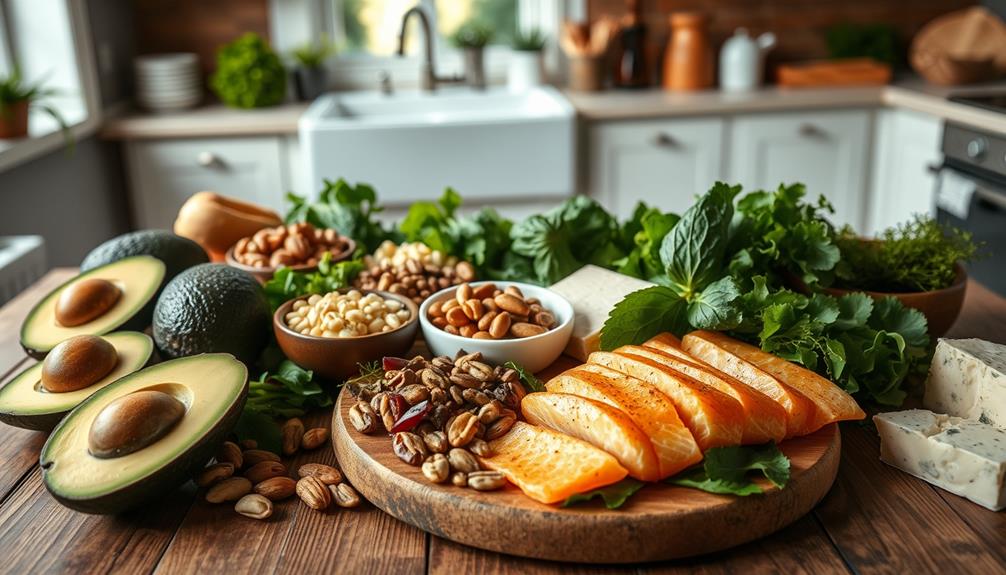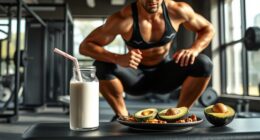The keto diet is a high-fat, low-carb eating plan that shifts your body's energy source from glucose to ketones. You typically consume 70-80% of your calories from healthy fats while limiting carbs to just 20-50 grams per day. This restriction induces ketosis, a state where your liver converts fat into ketone bodies for fuel. As a result, you may experience weight loss and improved insulin levels. However, watch out for potential side effects, like the "keto flu." There's a lot more to explore about the benefits and guidelines of this popular diet.
Key Takeaways
- The keto diet is a high-fat, low-carbohydrate eating plan designed to induce ketosis, where the body uses fat for energy instead of glucose.
- Carbohydrate intake is typically restricted to 20-50 grams per day, promoting the liver to convert fat into ketone bodies.
- The diet emphasizes healthy fats like avocados and nuts while limiting grains, sugars, fruits, and root vegetables.
- Benefits of the keto diet include weight loss, improved insulin levels, and potential neuroprotective effects for brain function.
- Risks include "keto flu," nutrient deficiencies, and potential digestive issues due to low fiber intake.
Overview of the Keto Diet
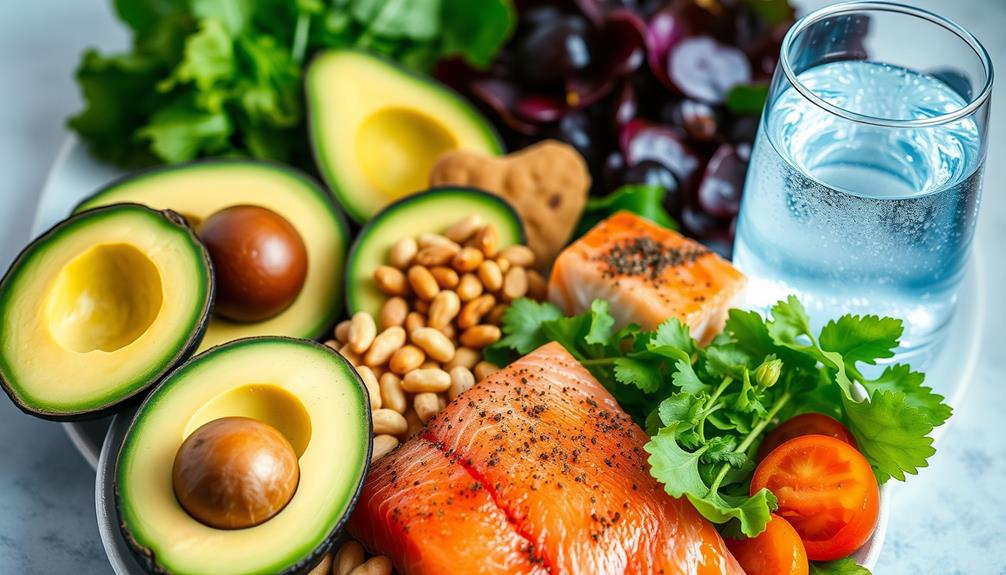
The ketogenic diet, which emerged in the 1920s primarily for epilepsy management, is a high-fat, low-carbohydrate eating plan that shifts your body into a state called ketosis. This dietary approach typically consists of about 70-80% fat, 15-25% protein, and just 5-10% carbohydrates.
By restricting your carb intake to 20-50 grams per day, your body changes from using glucose as its primary energy source to utilizing ketone bodies produced from fat. Additionally, the diet may provide some antioxidant benefits, which can support overall health, similar to the effects of Cranberry Juice Consumption.
In ketosis, you'll notice significant reductions in blood sugar levels and insulin, making this diet appealing for weight loss. The keto diet emphasizes healthy fat sources like avocados, nuts, and olive oil, while limiting high-carb foods such as grains, sugary items, and most fruits.
This carbohydrate restriction requires discipline, but many find it effective in shedding pounds. As you begin on this journey, you may experience a change in your energy source, leading to increased fat burning.
Understanding the fundamentals of the ketogenic diet will help you navigate the initial phases and make informed choices that align with your weight loss goals.
How Ketosis Works

Entering ketosis requires your body to adapt to a new energy source, primarily by cutting down carbohydrate intake to about 20-50 grams per day. This shift prompts your liver to convert fat stores into ketone bodies, which serve as an alternative fuel source for your brain and other tissues. As you reduce glucose availability, your blood sugar levels drop, leading to decreased insulin production.
During ketosis, the primary ketone bodies produced include acetoacetate, beta-hydroxybutyrate, and acetone. These compounds not only provide an efficient energy source but also help suppress appetite, contributing to weight loss. However, keep in mind that excess protein consumption can disrupt this process. When you consume too much protein, your body may convert some of it into glucose through gluconeogenesis, hindering your ability to remain in ketosis.
| Ketosis Mechanism | Key Components | Effects |
|---|---|---|
| Energy Source Shift | Ketone Bodies | Appetite Suppression |
| Reduced Carbohydrate Intake | Fat Stores | Weight Loss |
| Decreased Insulin Production | Glucose & Protein Consumption | Sustained Ketosis |
Dietary Guidelines and Food Choices
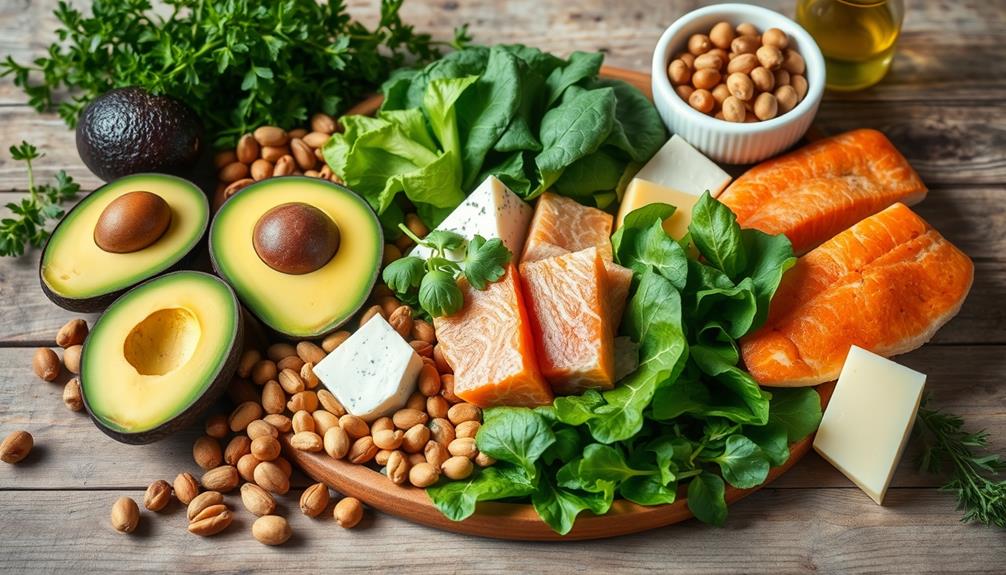
When following a ketogenic diet, you'll want to prioritize foods that are high in fat and low in carbohydrates. Typically, this means aiming for about 70-80% fat, 15-25% protein, and only 5-10% carbohydrates. Your food choices should include high-fat meats, full-fat dairy, avocados, nuts, and healthy oils like olive oil.
To maintain ketosis, limit your carbohydrate intake to around 20-50 grams per day, focusing on low-carb options like leafy greens and cruciferous vegetables. Additionally, incorporating regular physical activity can enhance your results on the keto diet, as it supports your overall health and helps manage insulin levels, a key factor in managing insulin resistance.
Meal planning is essential on the keto diet. Familiarizing yourself with food labels can help you avoid high-carb pitfalls. Look for keto-friendly recipes that align with your dietary goals.
Remember, the restrictive nature of the keto diet can lead to nutrient deficiencies if not properly managed. As a result, keeping an eye on your nutrient intake is vital.
As you navigate your dietary choices, steer clear of sugary foods, grains, most fruits, beans, and root vegetables. With careful planning and mindful choices, you'll be well on your way to successfully following the keto diet while enjoying a variety of delicious, satisfying meals.
Benefits and Health Impacts

Adopting a ketogenic diet offers a range of benefits that extend beyond weight loss. You'll likely notice significant reductions in body weight, with studies showing an average loss of 2 pounds more than those on low-fat diets. This is due to increased fat breakdown and better appetite control.
Additionally, the keto diet can provide benefits similar to natural remedies for cold relief, as it encourages the consumption of whole foods and emphasizes nutrient density. The keto diet can also improve insulin levels, making it particularly beneficial for individuals with type 2 diabetes or metabolic syndrome, as it lowers blood sugar levels and enhances insulin sensitivity.
Moreover, the neuroprotective effects of the keto diet can enhance brain function. Research indicates that increased ketone availability may lead to cognitive improvements, especially in Alzheimer's patients. For children with drug-resistant epilepsy, adhering to the ketogenic regimen has resulted in a remarkable reduction in seizure frequency, with some studies noting a 50% decrease.
Long-term adherence to the keto diet can improve metabolic health markers, such as lowering triglycerides and increasing HDL cholesterol levels. This contributes to a lowered risk of heart disease, making the keto diet a compelling option for those looking to improve their overall health while managing fat and carb intake effectively.
Potential Risks and Considerations
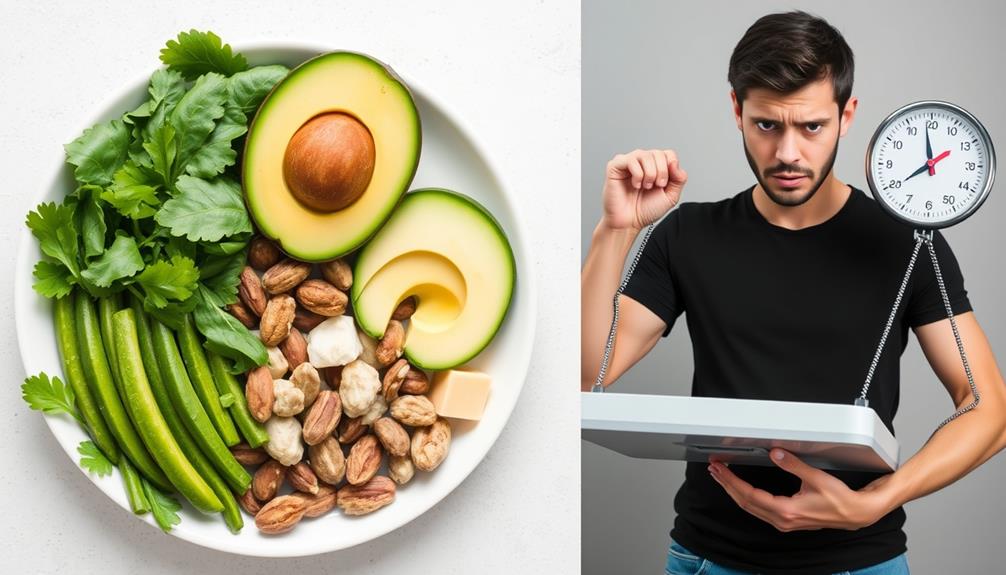
While many find success with the ketogenic diet, it's vital to recognize the potential risks and factors that come with it. One common concern is the "keto flu," a collection of symptoms like fatigue and headaches that can occur during the adaptation phase as your body shifts from carbs to fat for energy. This shift can be similar to the change period some women experience when undergoing regular health screenings such as mammography, which can also bring about temporary discomfort.
The diet's high saturated fat intake may also lead to increased LDL cholesterol levels, raising worries about cardiovascular health.
Due to the restrictive nature of the keto diet, you might face nutrient deficiencies over time, as it limits the variety of foods you consume. Additionally, excessive protein intake can pose a risk of kidney overload, particularly if you have pre-existing kidney conditions.
Long-term adherence to the diet could result in digestive issues, including constipation, largely due to its low-fiber content.
It's essential to evaluate these factors before fully committing to the ketogenic diet. If you decide to proceed, consult with a healthcare professional to guarantee you're addressing these potential risks and maintaining a balanced approach to your nutrition.
Comparing Keto to Other Diets
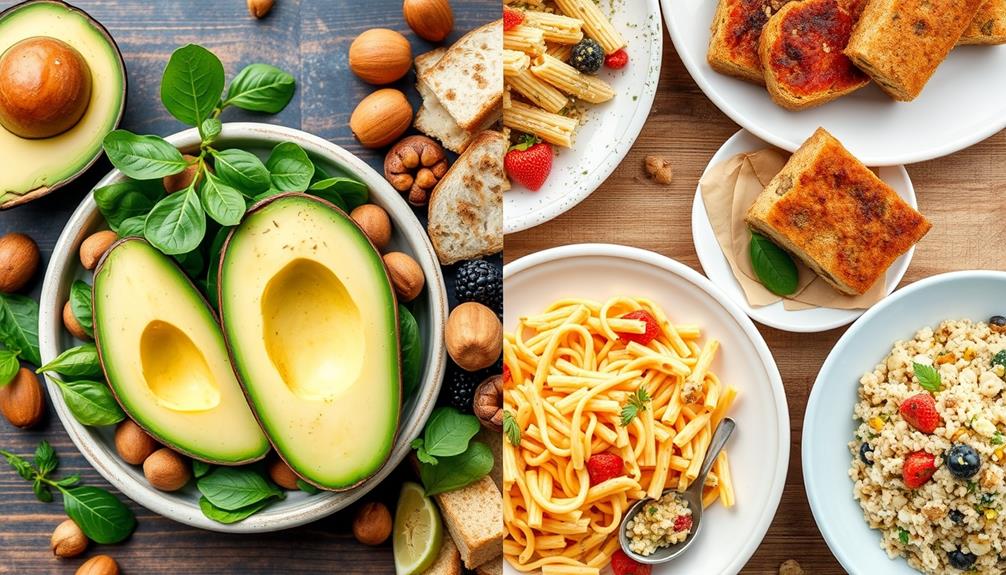
The ketogenic diet stands out among various dietary approaches due to its unique focus on high fat intake and strict carbohydrate limits to achieve ketosis. Unlike other low-carb diets like the Atkins and Paleo diets, keto diets emphasize a higher fat composition, requiring 70-80% of your daily calories from fats while limiting carbs to 20-50 grams daily. This distinct macronutrient composition helps induce ketosis, where your body burns fat for energy.
Here's a comparison of keto with other popular diets:
| Diet Type | Key Features |
|---|---|
| Keto | High fat intake, strict carb limit |
| Atkins | Lower carbs, gradually reintroduces carbs |
| Paleo | Focus on whole foods, more carb variety |
While both keto and the Atkins diet promote carbohydrate reduction, keto prioritizes maintaining high levels of ketone bodies for energy. In contrast, the Paleo diet allows for more carbohydrate sources, such as fruits and root vegetables. Research shows that keto often leads to greater initial weight loss, but questions about long-term sustainability remain, making it essential to evaluate your personal goals and lifestyle when choosing a diet.
Frequently Asked Questions
What Are the Basic Rules of a Keto Diet?
To follow the basic rules of a keto diet, you'll need to cut carbs drastically, focusing on high-fat foods while avoiding sugars and grains. Stick to strict macronutrient percentages to maintain ketosis effectively.
What Food Is Not Allowed in Keto?
You can't eat foods high in sugars, grains, most fruits, root vegetables, or legumes on keto. These items disrupt ketosis by increasing carbohydrate intake, making it harder for your body to stay in fat-burning mode.
What Foods Can You Eat on a Keto Diet?
On a keto diet, you can enjoy healthy fats like avocados and olive oil, non-starchy vegetables such as leafy greens and broccoli, and protein sources like unprocessed meats and eggs. It's delicious and satisfying!
What Is the Keto Diet and Does It Really Work?
Like a switch flipping, the keto diet drastically changes your body's fuel source. It can work for weight loss and health benefits, but long-term sustainability might be challenging once you return to regular eating habits.
Conclusion
In the grand tapestry of diets, the keto diet weaves a unique thread, offering a pathway to weight loss and health. By embracing low carbs and high fats, you ignite a metabolic fire, burning fat for fuel. However, like any journey, it has its pitfalls. So, as you navigate these culinary waters, weigh the benefits against potential risks. Ultimately, the choice is yours—embrace the richness of keto or explore other paths to wellness.
